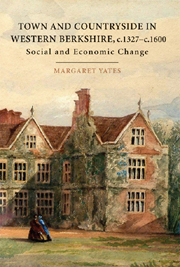Book contents
- Frontmatter
- Contents
- List of tables, figures, and maps
- Acknowledgements
- Abbreviations
- Sums of money
- 1 The end of the Middle Ages?
- 2 Landscapes, population and wealth in western Berkshire from the fourteenth to the sixteenth century
- 3 Town and country relations: Newbury and its hinterland
- 4 Estate management and profitability
- 5 Tenant society
- 6 Conclusion: the chronology of change
- Appendices
- Bibliography
- Index
6 - Conclusion: the chronology of change
Published online by Cambridge University Press: 05 February 2013
- Frontmatter
- Contents
- List of tables, figures, and maps
- Acknowledgements
- Abbreviations
- Sums of money
- 1 The end of the Middle Ages?
- 2 Landscapes, population and wealth in western Berkshire from the fourteenth to the sixteenth century
- 3 Town and country relations: Newbury and its hinterland
- 4 Estate management and profitability
- 5 Tenant society
- 6 Conclusion: the chronology of change
- Appendices
- Bibliography
- Index
Summary
The chronological coverage of this book has been constructed to bridge the historical fault line that delineates the end of the middle ages. We have been engaged in finding answers to the questions, ‘what changed, when, and why?’ through a detailed examination of town and countryside in western Berkshire. The purpose of this chapter is to draw together those features of the economy and society which have a chronological significance and allow us to chart change over time and to place Berkshire in its wider context. It will have the advantage of refining our understanding of change between the fourteenth and sixteenth centuries and assessing the typicality of the experience of western Berkshire. Moreover, we must determine whether the trends that are being observed were just short-term fluctuations or are evidence for structural change which had occurred within society and the economy. The final consideration of this chapter is an evaluation of the applicability and power of our chosen influences and their success in accounting for the local variations that were such a characteristic feature of pre-industrial societies.
In chapter 1 we created a framework of criteria capable of charting longterm trends between the fourteenth and sixteenth centuries. In the light of this case study we will refine the chronology now and demonstrate that the whole period from the late fourteenth to the end of the sixteenth century can be subdivided into five sections which had distinctive characteristics and within which we can identify regional variations.
- Type
- Chapter
- Information
- Town and Countryside in Western Berkshire, c.1327–c.1600Social and Economic Change, pp. 232 - 249Publisher: Boydell & BrewerPrint publication year: 2007



